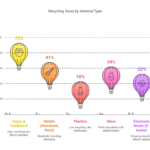The Canadian solar energy sector is on a trajectory of remarkable growth, with market size anticipated to expand by USD 2.25 billion between 2024 and 2029 at an impressive CAGR of 23.9%. As government incentives bolster renewable energy adoption and advanced financing models make solar increasingly affordable, industry stakeholders are preparing for a surge in demand for skilled professionals. From specialized engineers and installation technicians to project managers and renewable energy consultants, the evolving solar market opens diverse avenues for job creation and workforce development.
Staffing companies operating within this domain must stay ahead of solar energy trends to respond effectively to employer needs. Specialized training, technological expertise, and familiarity with industry regulations are becoming critical attributes for professionals. Below is a detailed assessment of the Canadian solar energy landscape—highlighting growth drivers, market segments, and workforce implications.
Key Market Drivers
- Expanding Government Support
- Policy Incentives and Subsidies: Federal and provincial programs promote solar power projects via grants, tax credits, and rebates. These initiatives stimulate labor demand, particularly among installers, engineers, and maintenance technicians.
- Commitment to Net-Zero: Canada’s drive toward lower carbon emissions encourages large-scale investments in solar, increasing the need for trained personnel to handle system integration and ongoing operations.
- Rural Electrification Efforts: In remote areas, solar projects receive government backing to replace diesel generators, providing new employment opportunities in areas previously dominated by fossil fuel supply chains.
- Growing Popularity of Pay-As-You-Go (PAYG) Models
- Affordable Access: PAYG programs spread the cost of solar installation over time, making it more accessible to homeowners and small businesses. Staffing needs in customer support, finance, and technical roles expand as more participants enter these financing schemes.
- Scalable Solutions: As PAYG adoption rises, so does the market for energy storage, grid connectivity, and monitoring services—further amplifying the demand for skilled specialists to handle billing, support, and hardware implementation.
- Demand for Clean, Low-Cost Energy
- Reduced Environmental Footprint: Solar power helps businesses and households shrink their carbon emissions. Corporate ESG (Environmental, Social, and Governance) goals accelerate solar adoption, prompting firms to recruit sustainability consultants, environmental engineers, and compliance experts.
- Public Awareness: Media coverage and public sentiment favor renewable energy, driving continued investment and creating new positions in areas like project management, supply chain, and technical support.
- Technological Advancements
- Improved Photovoltaic (PV) Cells: Research and development into more efficient, cost-effective PV modules sustains industry growth—pushing staffing requirements for laboratory researchers, product designers, and manufacturing experts.
- Energy Storage Innovations: Enhanced battery systems and power conversion devices enable more stable solar integration, particularly for off-grid applications. As storage tech evolves, so does the need for engineers and field technicians knowledgeable in battery chemistry and system maintenance.
Market Segmentation
By Application
- Grid-Connected
- Market Dominance: Grid-connected solar projects are projected to remain the largest segment through 2029. Residential and commercial customers feed excess power back into the grid, benefiting from net metering policies.
- Staffing Implications:
- Installation Teams: Electricians, solar technicians, and system designers.
- Maintenance & Monitoring: Trained personnel to ensure reliability and peak efficiency.
- Grid Integration Experts: Specialists focused on regulatory compliance and system interoperability.
- Off-Grid
- Key Drivers: Off-grid projects are vital in remote locations, including rural communities aiming to improve energy accessibility and reduce diesel dependency.
- Staffing Implications:
- Specialized Engineers: Familiar with standalone system designs, battery technology, and mini-grid architectures.
- Training & Support Staff: Personnel tasked with providing ongoing operational guidance in remote areas.
By End-User
- Utility
- Scale & Investment: Utility-scale solar power plants serve large segments of the population. Extensive capital investment requires a robust workforce to manage planning, construction, and grid synchronization.
- Roles in Demand:
- Project Managers, Environmental Specialists, Legal Advisors
- Monitoring and SCADA (Supervisory Control and Data Acquisition) Technicians
- Rooftop
- Commercial & Residential Focus: Rooftop installations continue to rise due to lower costs and favorable government incentives, creating broad opportunities for local contractors and engineering firms.
- Roles in Demand:
- Local Installers, Sales Representatives, Customer Support Specialists
- Electrical Inspectors, Permit Coordinators, Technical Advisors
By Technology
- Photovoltaic (PV) Systems
- Mainstream Adoption: PV modules remain the backbone of most Canadian solar projects.
- Advances in Efficiency: Ongoing R&D pushes energy conversion rates higher, fueling competitive hiring for R&D scientists and product testers.
- Concentrated Solar Power (CSP) Systems
- Niche Applications: While CSP is less prevalent than PV in Canada’s climate, it may find specialized uses in industrial processes or large-scale plants.
- Staffing Needs: Mechanical, thermal, and optical engineers who can manage complex CSP setups and integrated storage solutions.
By Geography
- Canada: This market analysis focuses exclusively on Canadian territory, where solar potential varies by province. Larger-scale installations occur in sunnier regions, but every province sees some level of commercial, industrial, and residential solar adoption.
Market Dynamics: Drivers, Trends, and Challenges
Primary Drivers
- Increasing Government Support for Solar: Tax incentives and the national push for cleaner energy remain catalysts for robust industry expansion.
- Growing Need for Skilled Labor: As solar capacity scales up, so does the requirement for a qualified workforce with expertise in renewable technologies.
Emerging Trends
- Pay-As-You-Go (PAYG) Expansion: Alternative financing reduces the barrier to entry, attracting homeowners and small businesses seeking affordable solutions.
- Digitalization of the Grid: Advanced monitoring systems and IoT-enabled devices optimize solar plant performance, calling for tech-savvy professionals.
Challenges
- Competition from Alternative Renewables
- Wind & Hydropower: Canada has a rich history in hydroelectric and wind generation, intensifying competition for investment dollars.
- Staffing Strategy: Workforce planners may need to diversify skill sets to match overlapping demand in other renewables.
- High Upfront Costs and Intermittency
- Capital-Intensive Installations: Despite long-term savings, initial expenses can deter certain adopters.
- Energy Storage Needs: Solar’s variability requires robust battery systems; staff must be adept at integrating and troubleshooting advanced storage solutions.
- Technical Expertise Gaps
- Skilled Worker Shortage: Canada’s solar sector demands qualified electricians, engineers, and technicians who are not always readily available.
- Operational Complexity: Maintenance, compliance, and system design all need specialized training—a key area for staffing firms to address.
Exclusive Customer (Employer) Landscape

Evolving Hiring Practices
- Early Adoption vs. Lagging Regions: Solar-savvy provinces (e.g., Ontario, Alberta) have mature hiring practices, while emerging solar markets in other provinces still grapple with a smaller talent pool.
- Training and Certification: Employers increasingly require prospective hires to have certifications like NABCEP (North American Board of Certified Energy Practitioners) or equivalent credentials.
Procurement and Price Sensitivity
- Project-Based Workforce: Many companies hire short-term or contract-based labor for installation projects, spiking staffing demand in construction seasons.
- Long-Term Operational Roles: Utilities and large corporations invest in full-time staff for system monitoring, technical support, and project management.
Key Companies & Market Insights
Major players in the Canadian solar market often partner with staffing agencies to quickly source specialized talent. Here are some prominent organizations shaping the industry:
- Azgard Solar Inc.: Focuses on farm, agriculture, and commercial solar solutions, requiring a diverse workforce that spans engineering to field technicians.
- BluEarth Renewables: Operates wind, hydro, and solar facilities—indicating a need for cross-trained renewable energy professionals.
- Canadian Solar Inc.: A globally recognized solar manufacturer with a broad hiring focus—covering R&D, manufacturing, sales, and support.
- Great Canadian Solar Ltd.: Delivers design and installation services, relying heavily on project managers, certified electricians, and site supervisors.
- HELIENE Inc.: Specialized module production underlines the importance of skilled assembly workers, quality inspectors, and engineers.
- miEnergy Inc.: Offers turnkey solutions, creating opportunities for marketing specialists, client liaison roles, and maintenance technicians.
As the solar market grows, staffing partnerships become vital to meet surging labor needs. Companies seek workforce solutions to find, train, and retain top-tier personnel who can align with ever-shifting project requirements.
Market Forecast Highlights
Growth Projections
- 2024 as Base Year: By analyzing current government policies and adoption trends, experts predict a 23.9% CAGR up to 2029.
- USD 2.25 Billion Increase: Rapid expansion underscores the urgent need for a robust, skilled workforce to maintain and maximize new installations.
Investment and Innovation
- Technology R&D: Companies intensify research on PV cell efficiency, advanced materials, and energy storage solutions, opening roles for scientists and high-tech engineers.
- Infrastructure Expansion: Grid upgrades, battery facilities, and off-grid microgrids require specialized teams capable of integrating novel technologies with existing energy systems.
Workforce Outlook
- Growing Demand for Training: Formal education and certifications in solar energy can expect higher enrollment, reflecting industry needs.
- Upskilling Opportunities: Experienced tradespeople (e.g., electricians, plumbers, HVAC technicians) can expand into solar-specific roles, enhancing career prospects and bridging talent gaps.
Conclusion and Staffing Implications
The Canada solar energy market is set to undergo transformational growth between 2025 and 2029. With multi-billion-dollar investments poised to reshape the nation’s power landscape, the corresponding demand for human capital is equally substantial. Staffing companies play an essential role in supplying the qualified professionals required across all facets of project development—engineering, construction, sales, marketing, and ongoing operations.
For organizations planning to launch or expand solar initiatives, partnering with a specialized staffing firm is paramount. Sourcing competent project managers, certified technicians, and administrative support staff can streamline execution and lower costs. Meanwhile, for job seekers—including recent graduates and experienced tradespeople—stepping into solar energy roles offers robust career paths, competitive compensation, and an opportunity to make a tangible environmental impact.
By understanding Canada’s solar market trends and focusing on workforce readiness, staffing partners can ensure that both the solar sector and its employees thrive in this dynamic, high-growth industry.
Key Data Overview
- Market Growth (2025–2029): Accelerating at a CAGR of 23.9%, with an estimated rise of USD 2.25 billion.
- Segments Analyzed:
- Application: Grid-Connected vs. Off-Grid
- End-User: Utility vs. Rooftop
- Technology: Photovoltaic vs. CSP
- Geographical Focus: Canada
- Driving Factors: Government subsidies, PAYG models, net-zero targets, and R&D breakthroughs.
- Challenges: High upfront costs, competition from other renewables, intermittency of solar power, and a shortage of skilled workers.
- Leading Companies: Bird Construction Inc., BluEarth Renewables, Canadian Solar Inc., Great Canadian Solar Ltd., HELIENE Inc., and more.
By strategically aligning workforce planning with these emerging opportunities and potential bottlenecks, staffing companies and energy sector stakeholders can mutually benefit from Canada’s growing solar market.









